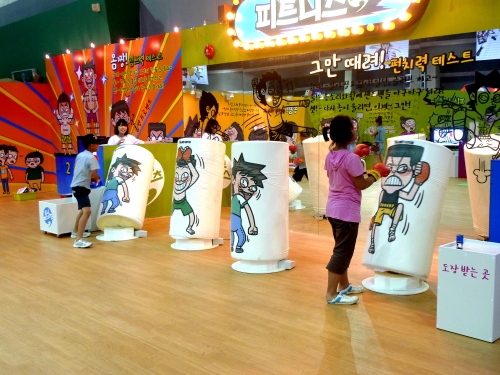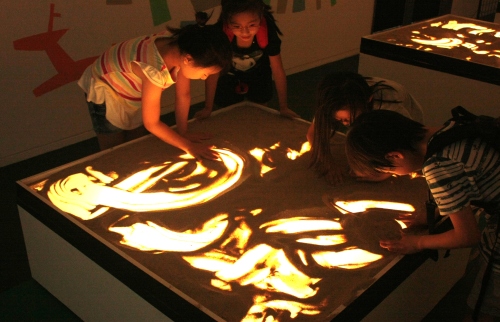Interactive exhibitions offer special summer experience for kids
Among many summer events for kids this year, interactive exhibitions are one special way for children to have fun indoors while avoiding the sun. From sports to arts and crafts to educational shows, these exhibitions require young visitors to engage in the programs instead of simply walking around looking at the exhibits. Here are three very different interactive exhibitions being held for children in Seoul, Jangheung and Busan.
Active fun in Seoul
Tooni Festival, which is currently being held at Argo-trade and Exhibition Center in southern Seoul, offers a dynamic program that combines real-life sports and games for kids.
There are all kinds of sports, including soccer, baseball, golf, and track and field. The interactive exhibition manages to make every featured sport more exciting, by offering game-like features for kids.
 |
Young visitors try boxing games at Tooni Festival being held at Argo-trade andExhibition Center in southern Seoul. (Tooniverse) |
For running exercises, for example, airbounce amusements are installed so kids can climb, hang, jump, and pass hurdles instead of just racing along the tracks. For young children who’d like to work on their flexibility, an entertaining game allows them to poke the funny-looking dolls while stretching their arms and shoulders.
For soccer, the young participants will be given an opportunity to play against the installed mock-ups of defenders. Mini golf courses and yoga sessions will allow the young participants to get a taste of less usual forms of exercise.
The festival also offers anime-themed interactive programs, featuring famous cartoon characters such as Pokemon and Tales Runner.
These video simulation games allow kids to have fun with their parents, as they are good fun for grown-ups as well. Most of these games are also sports-themed, including basketball, bowling, and water rafting.
Sung Soo-hee, one of the organizers of the event, said the event is supposed to be fun and easy, while staying physically involved.
“It’s easy for children to think exercising is something rigorous and boring,” Sung told The Korea Herald.
“Yet the festival makes the real-life sports more approachable for kids and lets them know that it can be fun and exciting. The key point is to make them play sports while they think that they are just playing.”
The festival runs through Aug. 28. For tickets and information, call (02) 371-9287.
Artistic experience in Jangheung
Located in Jangheung, Gyeonggi Province, Jangheung Art Park offers a special program for children to experience “sansuhwa,” Korea’s traditional landscape painting that mainly depicts scenery of mountains and rivers.
One of the most exciting interactive programs is its “3-D Sansuhwa experience,” where a room is decorated as a work of sansuhwa. The mountains are made with sponges, while the sun, moon and clouds are made of hanji, Korea’s traditional mulberry paper. It gives children the feeling that they are a part of the piece, while learning about the distinctive qualities of sansuhwa at the same time.
 |
Kids draw “sansuhwa,” Korea’s traditionallandscape art, with sand spread on a lightbox at Jangheung Art Park in Jangheung,Gyeonggi Province. Jangheung Art Park |
The institution’s “Sand Art Zone” offers an opportunity for children to create a sansuwha of their own with sand that is spread on a big light box.
“It is too challenging for children to create a piece of sansuhwa, realistically speaking,” said Song Hee-jin, the program director of Jangheung Art Park.
“But drawing on sand with fingers is spontaneous and fun, as if playing on the beach. The light boxes help the kids to see what they drew on the sand. Sand art is proven to be emotionally comforting and artistically stimulating for young children.”
The institution’s 3-D theater, on the other hand, plays a movie that’s based on the famous Aesop’s fable “The Tortoise and the Hare.” The movie’s background images are painted in sansuhwa style, allowing the young viewers to enjoy the famous story and the flair of sansuhwa at the same time.
Aside from sansuhwa programs, Jangheung Art Park also offers three arts and craft programs for young children. Its pottery class allows the kids to make their own plates and bowls and later paint them in their favorite colors.
The printmaking class, on the other hand, gives a rare opportunity for kids to create their own clay plates for engraving. Once the plates are completed, they print it either on a t-shirt or a handbag.
The last program is for kids who would like to decorate their umbrellas for rainy weather. Using color pens and crayons, the participating children get to personalize their umbrellas with their own drawings and use of color. The summer program runs through Oct. 16. For more information, call (031) 877-0500.
Learn eerie science in Busan
What makes us scared? Do ghosts really exist? Or are they just in our minds? In answer, a special interactive exhibition named “Ghost in Brain” at Busan Exhibition & Convention Center presents a very scientific overview on human fear and its psychology.
Co-produced by Fuji Television Network, Inc. of Japan and National Museum of Emerging Science and Innovation & Miraikan of Japan, the exhibition offers frights for young visitors who can then learn about how and why they were scared by what they saw and heard.
The exhibition is divided into three different parts: Fear Experience Zone; Fear Science Topic Zone; and Fear Observation Zone.
In Fear Experience Zone, children can go through more than 10 different fear journeys. The different themes include deserted homes, charnel houses, as well as a burnt down restaurant. Ghosts appear in the darkness out of the blue as the participants walk along the eerie exhibition halls.
In the second part of the exhibition, the visitors are presented with a series of scientific facts and analyses about the psychology of fear. The themes and facts include: how our brains conceive fear; the discovered fear factor gene; how trauma and fear can be related; case studies of supernatural phenomena and how they can be, in fact, a response of our brain when a certain part of it is stimulated.
The third part, “Fear Observation Zone,” is arguably the most exciting. It allows people to turn on the special sound and visual effects for visitors in the initial “Fear Experience Zone,” while being able to see their reactions through the installed cameras. Having already gone through the “Fear Experience Zone” by the time they arrive at this stage of the exhibition, participants can compare their initial reactions to the initial horror experience with those of others. By performing the special effects, participants can gain a rare grasp of how fear is perceived by the human brain and in what nature and order.
Children must be at least five years of age to enter. The exhibition’s simulation games are appropriate for young visitors under the age of 10, as they do not consist of blood or graphic situations, the organizers said.
“Ghost in Brain” runs through Sept. 13. For tickets and information, call 1588-2078 or visit www.ghosthouse.kr.
By Claire Lee (
dyc@heraldcorp.com)









![[Today’s K-pop] Blackpink’s Jennie, Lisa invited to Coachella as solo acts](http://res.heraldm.com/phpwas/restmb_idxmake.php?idx=644&simg=/content/image/2024/11/21/20241121050099_0.jpg)